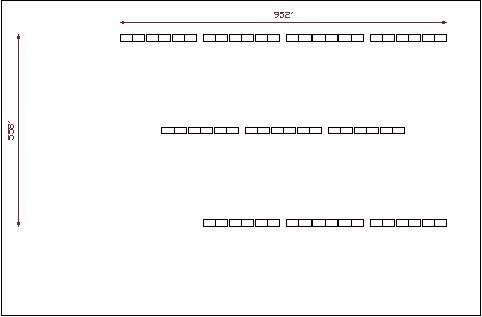Description of the century and maniple
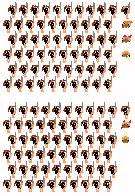 The configuration for the century most frequently given is an arrangement of 10 files and 6 ranks with the files on 0.9m (3’) intervals and the ranks on either 0.9m (3’) or 1. (4’) intervals. Delbrück suggests that each rank was offset to cover the gaps between men and to provide more room for maneuver. The figure shows that configuration for a maniple of two centuries arranged front to back. Some authors say this was a muster or maneuver formation and that in battle the two centuries would have been side by side, as they are depicted a little further on.
The configuration for the century most frequently given is an arrangement of 10 files and 6 ranks with the files on 0.9m (3’) intervals and the ranks on either 0.9m (3’) or 1. (4’) intervals. Delbrück suggests that each rank was offset to cover the gaps between men and to provide more room for maneuver. The figure shows that configuration for a maniple of two centuries arranged front to back. Some authors say this was a muster or maneuver formation and that in battle the two centuries would have been side by side, as they are depicted a little further on.
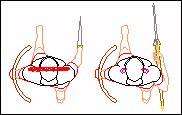 The centurion was identified by the transverse crest of feathers on his helmet. Later, the centuries acquired another officer, the optio, who is usually placed in the last rank. He is distinguished by two feathers on his helmet. The centurio and the optio appear in the frame at right.
The centurion was identified by the transverse crest of feathers on his helmet. Later, the centuries acquired another officer, the optio, who is usually placed in the last rank. He is distinguished by two feathers on his helmet. The centurio and the optio appear in the frame at right.
By all accounts the centurions led from the front right of the formation. Most authors give the centurion his own file, usually 1.2m (4’) wide.
Each maniple had its battle standards, at least by the late republic. After Marius, the battle standard for the legion became the aquila which was in the care of the primus pilus.
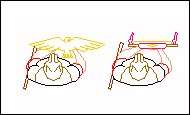 In the early legions the standards, at least those for the legion, may have been grouped behind either the first or second lines. It seems that after Marius the standards were carried toward the front, within the first three ranks, at least. There would be little point in putting a defenseless man, in charge of the unit’s most important emblem, in the front rank to be easily cut down. Yet all indications are that the standards were at the front someplace. The model will place the standards directly behind the centurion, in the second rank. The primus pilus may have also had the aquila in his care. The aquilifer is placed directly behind the primus pilus and the standards of the century behind him in the first century. In the second century the standard bearer is directly behind the centurion.
In the early legions the standards, at least those for the legion, may have been grouped behind either the first or second lines. It seems that after Marius the standards were carried toward the front, within the first three ranks, at least. There would be little point in putting a defenseless man, in charge of the unit’s most important emblem, in the front rank to be easily cut down. Yet all indications are that the standards were at the front someplace. The model will place the standards directly behind the centurion, in the second rank. The primus pilus may have also had the aquila in his care. The aquilifer is placed directly behind the primus pilus and the standards of the century behind him in the first century. In the second century the standard bearer is directly behind the centurion.
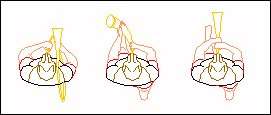 There were three types of horns used for signaling: the bucina, the cornu and the tuba. The three aeneatores (musicians) are shown in the drawing at right. There is some discrepancy in how different authors name the horns and describe their uses. The large circular horn is called either a bucina or a cornu. Some authors state that the bucina and cornu were used to give battle signals and the tuba to give camp and marching signals. Connolly assigns a cornicen to the first century of the maniple and a tubicen to the second century. The bucinatores he assigns to the cohorts. It may be that the same soldier used both the cornu and the tuba at different times and for different purposes.
There were three types of horns used for signaling: the bucina, the cornu and the tuba. The three aeneatores (musicians) are shown in the drawing at right. There is some discrepancy in how different authors name the horns and describe their uses. The large circular horn is called either a bucina or a cornu. Some authors state that the bucina and cornu were used to give battle signals and the tuba to give camp and marching signals. Connolly assigns a cornicen to the first century of the maniple and a tubicen to the second century. The bucinatores he assigns to the cohorts. It may be that the same soldier used both the cornu and the tuba at different times and for different purposes.
Following Connolly, a cornicen is assigned to the first century and a tubicen to the second. Their purpose would have been to sound orders to the men, presumably at the direction of the Centurion. With that in mind, their location in the formation would have had to be near enough the Centurion to receive information from him over the din of battle, yet not too close to the front line or else he would be a detriment to the formation. The model places them just behind the standard bearers.
The drawing below shows the first maniple in side-by-side battle formation. The century to the right is the first century of the first maniple with its centurion, the primus pilus, the legion’s aquilifer, the century’s signifer and a cornicen. On the left is the second century with its centurion, signifer, tubicen.
In this formation each century occupies a front of 10.98m (36’). If 1.52m (5’) are left between centuries for maneuver room, then the cohort occupies 68m (223’).
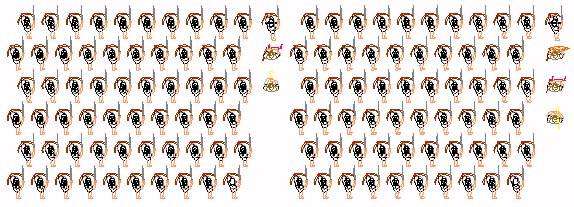 The legion formation based on the maniple arrangement described above is shown in the following drawing. The entire legion has a front of 290m (952’).
The legion formation based on the maniple arrangement described above is shown in the following drawing. The entire legion has a front of 290m (952’).


